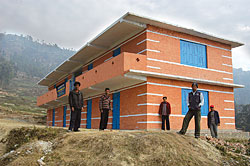 MIN RATNA BAJRACHARYA BUILT TO WITHSTAND: Locals of Chaling village, outside Bhaktapur collected money from the villagers to build Nateswari Primary School, which uses earthquake resistant architecture. |
"About one third of schools across the country are earthquake resistant now," says Yub Raj Paudyal, an engineer at the Department of Education, who has been working for the past 20 years to reinforce old schools and construct new classrooms to earthquake-resistant standards.
Nepal lies in a highly active seismic zone. The last big earthquake in August 1988 killed more than 700 people and destroyed 1,200 schools in eastern Nepal. Seismologists believe Nepal is overdue for another earthquake of similar magnitude.
After the 1988 earthquake, the government launched its Earthquake Affected Area Reconstruction and Rehabilitation Project, and in 2003 enacted a national building code for public buildings including schools.
The Department of Education's records indicate that 52,000 classrooms have been built since 1988, but a further 41,000 are needed just to serve current student numbers, and an additional 10,000 will be required by 2012 to meet the demand of the government's Education For All (EFA) program.
The department's budget has been increased to allow the building of 6,000 new classrooms this year, up from 2,000 per year. Schools can choose from a range of designs, including two-room blocks and multi-storey designs, according to their local requirements. If they draw up their own designs these must be approved to ensure they meet the standards of the national building code.
The designs are not guaranteed to be earthquake-proof, says Amod Mani Dixit, of the National Society for Earthquake Technology-Nepal (NSET). They are intended to reduce loss of life by giving people time to escape from the building before it collapses.
Nepal has no medical response capacity to deal with a disaster on the scale of the recent Sichuan earthquake. "Earthquakes don't kill people, bad buildings do," says Dixit. "They are not natural disasters, they are manmade, and there are solutions to reduce risk."
The reality is that Nepal is woefully unprepared. Nepal is the 11th most vulnerable country to earthquakes, and Kathmandu is the world's most vulnerable city in terms of its lack of preparedness.
NSET says it is largely a myth that earthquake-resistant technology is expensive, and argues that good design rather than expensive materials is the key to making a house safer. Yet, 86 percent of new houses are built without engineering oversight.
NSET, with support from international NGOs, has trained masons in building techniques, advised teachers on how to organise evacuation drills at schools, and built model earthquake-resistant schools in 26 districts.
Sonam Wangchuk, an education adviser with the Danish group, MS Nepal, has built a school in Bardiya district that is both earthquake-resistant and suitable for different climatic conditions-naturally cool in the hot Tarai but also solar-heated for the mountains.
"Rich nations spend a lot of money and artificial energy into making their schools comfortable," Wangchuk says. "Countries like Nepal and India can neither afford to nor need to."
MS Nepal has been looking at ways to make schools that are safe yet cheap to build and maintain, and use local materials and labour. Their design uses compressed, stabilised earth-blocks for the walls and thin cement sheets reinforced with chicken-wire for the roof. The ground floor lies three feet below the surface.
This not just insulates them from heat and cold, but also are less risky in an earthquake. "Nepal is setting out to build 50,000 new classrooms under the EFA programme in the next five years, it would be a good idea to test prototypes using different methods before plunging into just one," Wangchuk says.
At a time when the subcontinent is crying out for good school design, if Nepal is able to come up with an effective design it could become a model for the whole region.
Model school
Mangal Dvip School buildings in Bouddha were built in 1980 without considering precaution against natural hazards like earthquake and fire. After the 1988 earthquake, the classrooms remained intact, but it forced the school to plan for bigger future disasters.
"We sent our teachers to participate in safety and first aid drills which they pass on to our students later," says Khenpo Chonyi Rangdrol, principal of the school. The school then started retrofitting the buildings, which was completed last year. Retrofitting is done by adding external columns, jacketing beams and columns to bear the load during quakes. Drills are held three times a year.
Yub Raj Paudyal, engineer at the DoE, says most private schools in the capital are located in buildings that were originally family residences. The classrooms are overcrowded and not quake- resistant-a recipe for disaster.
Says Paudyal: "We can reduce the risk by retrofitting."


